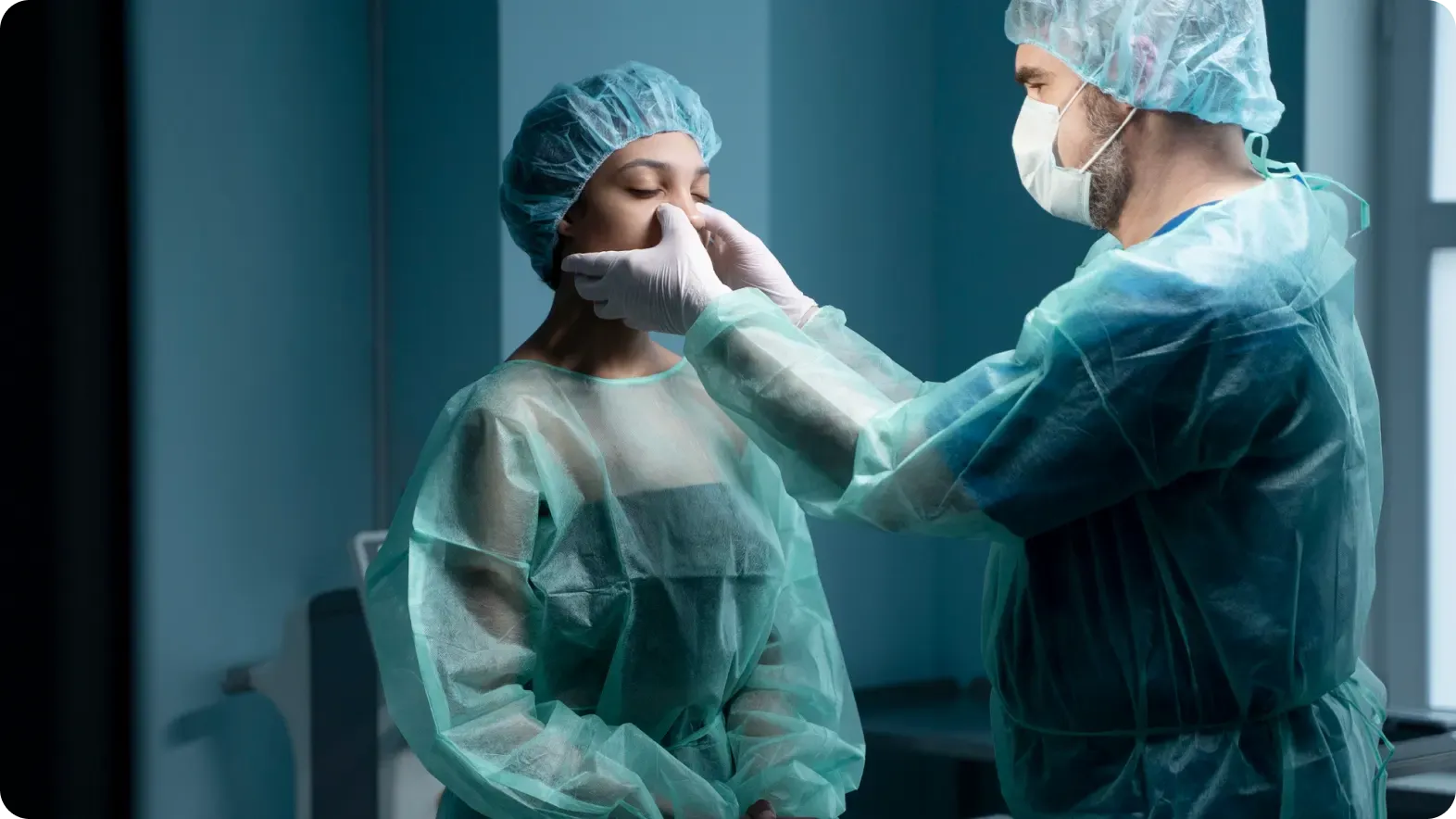Rhinoplasty Recovery Demystified: Timeline, Swelling Dynamics, and When Final Results Emerge
November 20, 2025
Rhinoplasty is one of the most technically nuanced operations in facial plastic surgery—and so is the recovery. The operating room sets the framework; your healing fine-tunes the final shape. When you understand the phases of recovery, the biology behind swelling, and realistic milestones, you’ll make better decisions and stress a lot less.
This guide walks you through what to expect from day one to the final reveal, with practical steps to support healing and clear criteria for when to call your surgeon. Always follow your surgeon’s protocol; individual techniques and anatomy can change recommendations.
This guide walks you through what to expect from day one to the final reveal, with practical steps to support healing and clear criteria for when to call your surgeon. Always follow your surgeon’s protocol; individual techniques and anatomy can change recommendations.
Immediate Post-Operative Phase (Days 0–7): What Happens and Why
In the first week, your body responds to surgery with inflammation, fluid shifts, and early tissue repair—normal, purposeful processes that can look dramatic. That’s biology doing its job.
Anesthesia emergence, PACU monitoring, and discharge criteria
After surgery, you’ll wake in the post-anesthesia care unit (PACU). Nurses will keep a close eye on:
- Airway and breathing (oxygen saturation)
- Blood pressure/heart rate stability
- Nausea control and pain level
- Bleeding from the nostrils and dressings
- Ability to drink and void
Splints, internal packing, and external dressings: purpose and care
- External splint (thermoplastic or aluminum): Stabilizes nasal bones and soft tissues, reduces swelling, and protects the new shape. Usually stays on 5–7 days.
- Internal splints (e.g., Doyle): Soft silicone splints may sit inside the nose to support the septum—especially after septoplasty—and are typically removed around day 5–7.
- Packing: Many surgeons avoid bulky packing. If used, it’s for bleeding control or septal support and usually comes out within the first few days.
- Tapes: Paper tape on the bridge or tip helps counter swelling and hold contours.
Acute swelling, bruising, and expected pain profile
- Swelling (edema): Peaks in 48–72 hours. It often shows up around the cheeks and under the eyes (periorbital area), especially if osteotomies were done.
- Bruising (ecchymosis): Common around the lower eyelids, shifting from purple to green/yellow over 5–10 days.
- Pain: Usually moderate and manageable with acetaminophen and, if prescribed, a short course of opioids. Most people notice congestion and pressure more than sharp pain.
Red flags versus normal findings: when to call your surgeon
Normal:
- Light oozing of blood/mucus for 24–48 hours
- Congestion, decreased smell, upper-lip stiffness, or mild teeth sensitivity
- Low-grade fever (<100.4°F/38°C) in the first 24 hours
- Heavy bleeding saturating the drip pad more than once per hour
- Vision changes, severe eye pain, double vision, or bulging (emergency)
- Severe, worsening pain not relieved by medication
- Fever >101.5°F (38.6°C) after day 2
- Increasing unilateral nasal obstruction with pain (possible septal hematoma)
- Purulent drainage or foul odor
- Skin blistering under the splint/tape, or a splint that shifts significantly

Early Recovery (Weeks 2–4): Subacute Healing and Activity Progression
Once the splints come off, breathing and appearance usually start to improve. This phase is all about reducing swelling, easing back into normal life, and keeping the nose clean (but gently).
Timeline for splint removal, suture care, and tape strategies
- External splint removal: Typically at 5–7 days. The nose may look swollen and a touch “upturned” at first—totally normal.
- Sutures: External columellar sutures (open rhinoplasty) come out around day 5–7. Internal absorbable sutures dissolve over a few weeks.
- Taping: Some surgeons recommend nighttime taping for 1–3 weeks to curb supratip swelling and support the tip. Techniques vary—follow your surgeon’s game plan.
Modulating edema: elevation, cold therapy, and salt restriction
- Elevation: Sleep on 2–3 pillows or a wedge for the first 2 weeks.
- Cold compresses: Use around the eyes (not directly on the nose) for 10–15 minutes, several times a day during days 1–3, to cut periorbital swelling.
- Sodium intake: Keep salt low to limit fluid retention.
- Hydration and protein: Fuel healing with adequate fluids and a balanced, protein-rich diet.
Return-to-work, exercise thresholds, and travel considerations
- Work/school: Many people return at 7–10 days once bruising and swelling subside. Remote work can start earlier.
- Exercise:
- Light walking: immediately
- Low-impact cardio: after 2 weeks if there’s no bleeding
- Strenuous exercise/weightlifting: around 3–4 weeks
- Contact sports or any activity risking nasal impact: avoid for 6 weeks (bone-healing window)
- Travel: Short flights are often fine after 1–2 weeks if cleared. Cabin pressure may cause temporary swelling—hydrate and walk periodically.
Sleep positioning and nasal hygiene (saline irrigations, ointments)
- Sleep: On your back with your head elevated; avoid side pressure.
- Hygiene:
- Saline spray every 2–3 hours while awake to keep tissue moist
- Gentle saline irrigations (if permitted) once splints/packing are out—no forceful blowing
- A thin layer of petrolatum or mupirocin (if prescribed) along incision lines and nostril rims
- Don’t insert cotton swabs deeply; only clean what you can see
Intermediate Remodeling (Months 2–6): Swelling Patterns and Shape Evolution
Now comes the slow, steady refinement. Lymphatic channels reopen, soft tissue tightens, and the nose takes on its new identity.
Lymphatic drainage normalization and soft-tissue contracture
Surgical dissection temporarily disrupts lymphatic flow. Over weeks to months, drainage pathways normalize and fibroblasts lay down collagen. That controlled contracture—your body’s internal tailoring—helps refine contours, especially in the midvault and supratip.
Tip edema versus dorsal definition: differential resolution
- Dorsum (bridge): Usually defines sooner—often crisp by 2–3 months.
- Tip and supratip: Thicker, more fibrofatty tissue holds fluid longer. Tip refinement lags behind, with visible improvements between months 3–6 and more subtle changes beyond.
Scar maturation phases (inflammation, proliferation, remodeling)
- Inflammation (days 0–7): Swelling and redness
- Proliferation (weeks 1–6): Collagen deposition; scars can feel firm
- Remodeling (months 3–12+): Collagen realigns and softens; redness fades
Steroid injections, taping, and other edema management adjuncts
- Intralesional steroids: Low-dose triamcinolone (commonly 2.5–10 mg/mL) can be carefully injected into focal supratip fullness or thickened scar tissue between months 1–6 to reduce persistent edema. It’s selective—overuse risks skin thinning.
- Taping: Nighttime paper tape for several weeks can support the supratip, especially in thick-skinned patients.
- Medical skincare: Gentle keratolytics (e.g., salicylic acid) may improve sebaceous skin texture—start only after incisions heal and with your surgeon’s okay.

Long-Term Outcomes (Months 6–18+): When Results Stabilize and What to Expect
By six months, most patients look close to their “new normal,” though the tip continues to refine. Final results take patience—worth it, but yes, it’s a slow burn.
Milestones for final tip refinement and symmetry assessment
- 6 months: 70–85% of swelling resolved; socially stable appearance
- 12 months: Typical endpoint for primary rhinoplasty
- 18–24 months: Thick skin, revision cases, and extensive tip work may keep evolving
Ethnic skin considerations, sebaceous skin, and thick soft-tissue envelopes
Patients with thicker dermis and subcutaneous tissue—common in many ethnic noses—may notice:
- Slower resolution of tip edema
- Possible need for adjuncts (conservative steroid injections, extended taping)
- Greater emphasis on framework support (e.g., tip grafts) to project through soft tissue
Breathing function, internal valve dynamics, and turbinate healing
Post-op congestion can linger for weeks as the mucosa heals. If you had septoplasty, spreader grafts, or turbinate reduction:
- Internal valve swelling and crusting usually recede over 1–3 months
- Breathing often improves beyond baseline once the mucosa settles
- Persistent obstruction deserves a check for synechiae (scar bands), residual deviation, or valve collapse
Photographic follow-up and when to consider revision consultation
Surgeons commonly schedule photos at 3, 6, and 12 months. Consider a revision consultation if, after 12–18 months:
- Aesthetic goals remain unmet due to structural issues (not just lingering swelling)
- Breathing problems persist despite appropriate healing
- Asymmetries are stable and significant

Practical Guidance and Evidence-Based Expectations
Realistic timelines: what 20%, 80%, and 100% healed actually mean
- 20% “healed” (1–2 weeks): Splints are off, bruising is largely improved, and you’re presentable with makeup or concealer. Congestion and tip swelling stick around.
- 80% “healed” (3–6 months): Dorsal definition is close to final; the tip is softer and still mildly swollen. Most people won’t notice the rest.
- 100% “healed” (12–18+ months): Tip refinement complete, scars matured, sensation mostly normalized. Thick skin and revisions can take up to 24 months.
Medication roadmap: analgesia, antibiotics, steroids, and NSAID cautions
Always follow your surgeon’s plan—protocols vary with technique and risk profile.
- Pain control:
- First-line: scheduled acetaminophen for 48–72 hours
- Short-course opioids only as needed; add a stool softener to prevent constipation
- NSAIDs: Many surgeons avoid non-selective NSAIDs (ibuprofen, naproxen) for ~5–7 days due to bleeding risk, then allow as needed. Some may use COX-2–selective agents (e.g., celecoxib) around surgery.
- Antibiotics: Evidence for routine prophylaxis after clean-contaminated intranasal surgery is mixed. Short courses are common when grafts, splints, or packing are used (typically 3–7 days).
- Steroids/antiemetics: A perioperative dose of dexamethasone is often used to reduce nausea and early swelling. Oral steroid tapers (e.g., Medrol Dosepak) are selective—discuss pros and cons (mood shifts, insomnia, hyperglycemia).
- Decongestants: Short-term oxymetazoline can help stop minor bleeding or relieve congestion—limit to 2–3 days to avoid rebound.
- Topicals: Petrolatum or prescribed ointment on incision lines; avoid neomycin if you’re sensitive.
Lifestyle factors: nicotine, alcohol, sun exposure, and supplements
- Nicotine (smoking, vaping, nicotine gum): Reduces blood flow and oxygen delivery—raising risks to skin and cartilage. Aim for zero nicotine for several weeks before and after surgery.
- Alcohol: Promotes vasodilation and swelling. Skip for at least 1–2 weeks, then go easy while swelling persists.
- Sun exposure: UV can darken bruises and irritate healing skin. Use SPF 30+ daily and a wide-brim hat; protect the nose and scars for at least 3 months.
- Supplements/medications: Many increase bleeding risk—avoid unless cleared by your surgeon:
- Aspirin, non-selective NSAIDs (early phase), fish oil, vitamin E, ginkgo, ginseng, St. John’s wort, high-dose turmeric, and certain herbal blends
- Ask about resuming your usual supplements at your first post-op visit
Frequently asked scenarios: glasses, masks, sneezing, and flying
- Glasses: Avoid resting frames on the bridge for 6 weeks (longer if osteotomies were performed). Options: tape glasses to the forehead, use cheek-supported devices, or try lightweight frames.
- Masks: Choose light, ear-loop masks that don’t press on the nasal dorsum. A soft gauze barrier can help.
- Sneezing and nose-blowing: Sneeze with your mouth open to reduce intranasal pressure. Avoid forceful nose-blowing for 2 weeks; gentle sniffing and saline sprays are your friends.
- Flying: Generally fine after 1–2 weeks with surgeon approval. Expect some temporary swelling; hydrate, use saline spray, and walk the aisle periodically.
Putting It All Together: What You Can Do Now
Prep your space: extra pillows, a bedside humidifier, saline sprays, and filled prescriptions.
- Plan your calendar: light work at 1–2 weeks, exercise at 3–4 weeks, contact sports after 6 weeks, and professional photos at 3–6 months.
- Set expectations: the early reveal isn’t the final result—tip refinement can take a year or more.
- Stay connected: keep all post-op visits and speak up early if something feels off.
Conclusion
Rhinoplasty recovery isn’t a sprint—it’s a series of predictable biological steps that end in a refined, functional nose. The first week focuses on safety and swelling control. Weeks 2–4 get you back into routines and emphasize hygiene. Months 2–6 bring real definition and remodeling, while months 6–18 deliver the nuances—especially at the tip.
With realistic timelines, disciplined aftercare, and open communication with your surgeon, you can move through each phase confidently and give yourself the best chance at an excellent outcome. Ready for the long game? Your nose is, too.
With realistic timelines, disciplined aftercare, and open communication with your surgeon, you can move through each phase confidently and give yourself the best chance at an excellent outcome. Ready for the long game? Your nose is, too.

Schedule Your Appointment with Dr. Mourad
If you are considering facial plastic surgery and want results that enhance your natural beauty without looking overdone, schedule a consultation with Dr. Moustafa Mourad today. You will receive personal, expert guidance at every step—from your first visit to your final result.
From Our Blog

December 8, 2025 | Dr. Moustafa Mourad | Uncategorized
Ethnic Rhinoplasty: Respecting Heritage and Identity Through Tailored Surgical Technique
Elective facial surgery is powerful. It can boost confidence, restore function, and reshape how someone is viewed—and how they view themselves. That’s especially true with rhinoplasty. “Ethnic rhinoplasty” isn’t a separate operation;
READ THE ARTICLE
December 8, 2025 | Dr. Moustafa Mourad | Uncategorized
Non-Surgical Alternatives vs. Surgical Rhinoplasty: What You Need to Know About Liquid Rhinoplasty (Filler) Versus Surgery
Elective changes to the nose sit right where aesthetics meets function. Some people want to smooth a small hump without taking time off work; others need true structural change and better airflow. Today, you’ve basically got two very different routes.
READ THE ARTICLE
December 8, 2025 | Dr. Moustafa Mourad | Uncategorized
Open vs. Closed Rhinoplasty: Which Technique Is Right for You? Differences, Pros, and Cons
Rhinoplasty isn’t one single operation—it’s a toolkit of techniques that reshape the nasal framework to improve how your nose looks, works, or both. The two main approaches—open (external) and closed (endonasal)—are simply different ways to reach the same anatomy.
READ THE ARTICLE
December 8, 2025 | Dr. Moustafa Mourad | Uncategorized
Which Type of Nose Surgery Is Best for You?
Your nose plays a big role in how your face looks and how you breathe. For some people, it’s about refining appearance. For others, it’s about improving airflow or correcting past surgeries. No matter the reason, the goal is the same: to create a natural, balanced result that fits your face and function.
READ THE ARTICLE